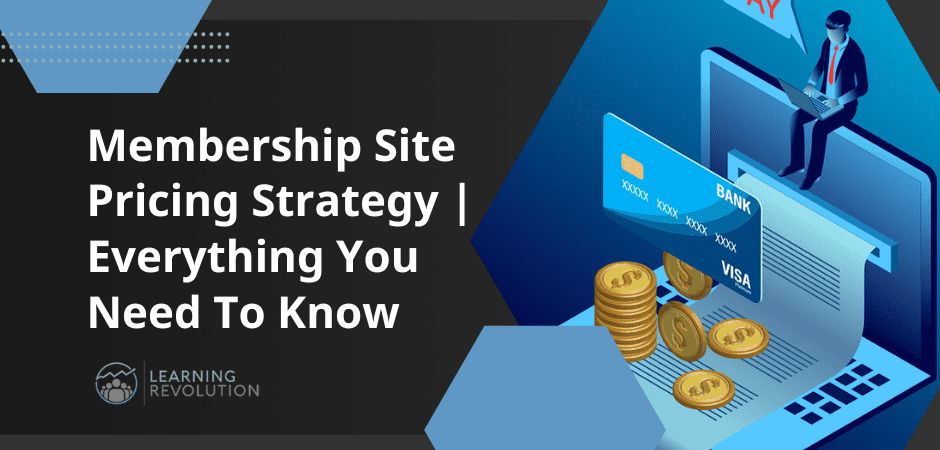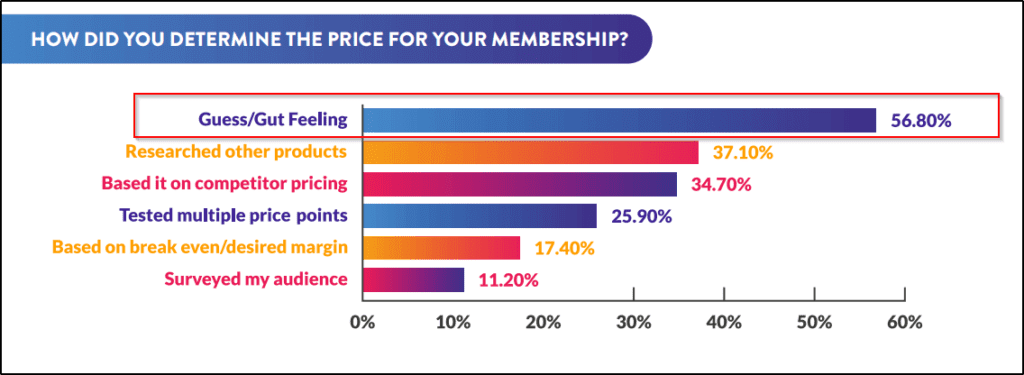

You know why every digital product seller dreams of owning a successful membership site? Because it’s the most reliable path to a consistent, recurring, passive income without launching new products again and again.
But choosing the right pricing for a membership site is quite tricky. You don’t want to price it so high that people think it isn’t worth paying for every month. But you also don’t want to sell cheap.
You also need to figure out the best pricing model for your membership program. Annual membership, monthly rate, or a hybrid program – what should it be?
Plus, you need to answer several other pricing questions before finalizing your membership program.
So, to make your task easier, we’ve dedicated this article to membership site pricing. We’ll cover different pricing models and discuss the factors you should consider when setting your membership program’s price.
Let’s get started.
What Is Membership Pricing And How Is It Different?
Membership is a subscription-based model in which the subscribers pay a monthly, quarterly, or annual fee to access exclusive members-only content, tools, and resources. It is among the most popular digital product models that allows you to generate recurring revenue and build a community-driven eLearning business that keeps growing in value with time.
Membership site pricing differs from stand-alone online courses, training programs, and digital products. It focuses on maximizing customer lifetime value and generating consistent revenue instead of one-time payments.
Pricing a membership program is a unique challenge because customers perceive memberships differently from conventional digital products.
Let me explain.
In digital products with one-time payments, the customer questions your product’s value only once at the time of payment. Once they pay, their anxiety levels go down and they move on with life.
In a membership program, the customer has to pay a subscription fee every month. So, they question themselves if it’s worth staying on as a subscriber every month. To keep them paying, you need to justify your membership price by finding the right balance between value and affordability while considering your revenue targets from the program.
To create this win-win scenario, you need to carefully develop a membership pricing strategy that not only attracts members but also convinces them to retain their membership.
Types Of Membership Pricing Models
There are multiple types of membership pricing models you can use for your site depending on your program’s value, content, and target audience.
Let’s discuss each membership pricing model in detail.
Free Trial/Membership
A free trial or free membership isn’t technically a pricing plan. But you need to see it as one because free members who’ve benefited from your content are the most likely to upgrade to a premium plan.
SmartInsights membership program is an excellent example of how a free membership can drive growth for your business.


There are two ways to handle free members.
You can offer them a limited (7, 14, or 30 days) free trial during which they have full access to your content. Once the trial period ends, they must upgrade to retain access.
The other option is to offer a lifetime free membership with limited content. Free members can only access free modules and courses and need to upgrade to a premium plan to access the more advanced content.
Flat Monthly Pricing
Most membership sites use a flat monthly pricing model in which the members pay a certain amount to access your premium content. This model is popular because of its simplicity and flexibility for site owners and customers since there’s no long-term commitment. Members can pay as long as they find your content useful and affordable, and discontinue their membership whenever they want.
Peak Freelance, a leading membership program for freelance writers, is an excellent example. It charges a flat monthly fee of $49/month to give members access to its wide range of training products.


This model also drives more member engagement since your subscribers pay monthly, which is a reminder to use their membership privileges.
The downside of this pricing model is its volatility. If most of your members are on a monthly plan, you might experience significant income fluctuations depending on your content quality, update frequency, technical issues, and economic conditions.
Discounted Annual Pricing
Many membership programs that use a monthly subscription fee combine it with a discounted annual price. This approach has several benefits:
- The customer gets a 10-20% discount increasing your conversion rates (who doesn’t love deals).
- Gives you a whole year’s worth of membership fee.
- The members don’t question your program’s value every month.
- You achieve financial stability.
But it has a few downsides as well:
- Annual members often lose interest after the initial months of their membership. As a result, they don’t use your content to its full potential.
- Annual members rarely renew their subscriptions.
- You have to start with a loaded membership program to charge annual fees.
Subscription + Optional Add-Ons
This is a hybrid pricing model where you charge a nominal subscription fee to grant members access to your premium content. But give them the option to choose resources, training content, or tools as add-ons.
For example, a membership program with twelve different training courses charges customers $11/month for membership + one foundational course. Then, the members can access additional courses for a course-specific monthly fee.
This model allows customers to only pay for the content they use. From a business owner’s perspective, this model drives easy conversions and guarantees a minimum subscription fee to cover your costs. In addition, it drives revenue from add-ons and creates a win-win scenario.
It’s similar to HP’s pricing strategy for its printer range.
HP introduced its printers at a high price tag but charged nominal rates for cartridges and refills. But after a poor market response, HP flipped its pricing model by giving away printers for a low price that only covered its cost. But started charging premium rates for cartridges and refills. Because once a customer gets a printer, they must also purchase cartridges.
Applying the same model to your membership program can be a game-changer.
Tiered Membership
Tiered membership is another popular way to make your membership pricing more affordable and flexible. Instead of offering a flat monthly or annual rate, a tiered membership consists of multiple subscription plans with varying offers.
For example, depending on your audience segments, you could offer beginner, pro, and advanced plans. The basic plan could only consist of your fundamental courses and monthly updates. The pro plan could include more training videos, resources, and community group access. And the advanced plan could include monthly one-on-one calls.
Group Membership Rate
Group membership is an innovative pricing model in which multiple customers join hands to purchase a membership plan at a slightly discounted rate.
Membership programs usually offer group plans for corporate customers. Digital Marketer Lab is a good example of this.


But you can create them for regular customers as well using the group buying business model.
Here’s how it works.
If three or more customers apply for your program as a group, they get a discounted rate. You can also create discount slabs depending on the number of customers in a group.
How To Determine Your Membership Site’s Pricing
We’ve discussed different membership pricing models. But how do you reach a price tag for your program? What factors do you consider before reaching a number?
Consider this stat to give you an idea of the complexity of these questions.


According to a survey that questioned more than 2300 membership site owners, nearly 57% used gut feeling to set their program’s price.
There are better strategies, of course.
But most site owners have no idea how they should price their membership site. Unfortunately, I can’t give you a magic number or a foolproof formula for calculating your membership program’s price.
No one can.
But I can tell you the factors to consider and research before setting your membership price. If you closely analyze these factors, you’ll have a pretty good idea of your program’s worth and the optimal price tag, making it a win-win for you and your customers.
Let’s discuss those factors one by one.
Offer Size And Value
What does your membership program contain? What do members get for signing up? What’s the value you’re offering? How many pieces of content are included in the membership?
Your program’s value and size play a critical role in making your program attractive to your prospects.
For starters, it should provide immense value and solve clearly defined problems. It needs to make a tangible promise and deliver on its commitment to the members. Because your program’s value depends on the significance of the problems it solves.
For example, a membership program for freelance writers can offer one or more of the following solutions:
- Help members become better writers.
- Get more customers
- Build more credible writing brands
- Build a sustainable writing business
- Network with other writers
Paying for your program should also make financial sense. For example, if your annual subscription rate is $499 and you help members get clients worth $30,000 in a year, investing in your membership is a no-brainer.
But offering value isn’t enough to justify a monthly subscription price. Your program should also contain multiple content pieces to increase its perceived value from the outside.
The simple way to do this is by breaking down longer lessons into bite-sized video lessons organized in modules.
So, before choosing a price tag, question the value and size of your program and see if it is solving a significant problem that’ll help your members achieve a positive ROI.
Offer Life
Does your membership solve an immediate problem or a long-term need? Do customers need to remain members to benefit from your offer, or can they learn the solution from your content and cancel their membership?
This is critical in determining your membership pricing because it directly impacts your customer’s lifetime value.
Let me explain with an example.
CopySchool is among the best copywriting membership programs in the world. Even at a discounted rate, members need to pay anywhere between $99 to $120 per month to access its content.
But to benefit from CopySchool, the members need to stay subscribed because it offers scenario-based training. It is positioned as a program that copywriters can use to get proven copywriting frameworks and templates when working on a client project.
In comparison, imagine a membership program that teaches traffic generation strategies. Once you understand how to drive traffic with SEO or advertising, you won’t need to stay subscribed.
So, think of the average number of months a customer needs to stay with your program to benefit from it. Then use different price points to see how much you can make over a customer’s lifetime.
Operational Costs
You can’t run a membership program from your pocket. So, you must calculate your operational costs and price your program to cover them and make a profit.
The typical costs involved in running a membership program are:
- Membership platform fee/website hosting
- Email marketing software
- Virtual Assistant
- Freelancers for content creation
- Any other content creation costs (video, PDFs, articles)
- Additional website plugins
You need to factor in this price when considering a minimum per-customer subscription price.
Market Size/Subscription Base
Your target audience size is a crucial factor in determining your subscription price. But you can’t determine your market size without extensive market research.
So, to get an idea of whether your solution is in-demand, research the top sites, forums, social media groups, and any other online platforms. Check if other membership programs exist in your niche and how frequently people subscribe to them.
If you’re in a high-demand market, you can lower your profits to focus on volume sales. But if your niche is in-demand but has a small size, you’d ideally want to create a high-value offer at a premium subscription rate.
Revenue Target
How much do you expect to make from your membership program depending on your market size and offer value?
To give you an idea, only 12% of membership programs that have been around for less than three years have 500 or more active members.
So, let’s say your initial target is $5,000 per month from your membership program. At a monthly subscription price of $50, you’ll need 100 paying members to reach that goal. Or you could lower the price to $25/month and reach that goal with 200 paying members.
How many paying members you can get depends on your market size, offer value and marketing strategy.
Recurring Time Commitment
Another important consideration when setting your membership price is the amount of time you need to dedicate every month to create new content, engage with your members, and manage website operations.
Ideally, you’d want to spend as little time as possible on your membership site after creating the initial content. However, you may need to spend anywhere between 20 to 50 hours per week managing your site, depending on your niche and core offer.
The more time you have to spend every month, the more you must charge because otherwise, it would kill the purpose of your membership site (which is to generate recurring passive income)
Need Urgency
How badly and urgently do your prospects need your solution? This is another critical factor to consider when setting your membership price.
You’ll struggle to sell high-ticket memberships if there’s no urgency in your offer. In contrast, an offer everyone wants to get their hand on quickly can be sold for as much as you want.
Analyze Competitors
Finally, once you consider all the factors we’ve discussed, research your closest competitors to analyze their membership offer, price, positioning, and everything else about their business.
Get a ballpark figure for your subscription price based on the average rates most of your competitors are charging for a similar membership offer.
Then realistically evaluate your offer to see how it is better than your competitors and why you should charge higher monthly rates.
So, for example, if your competitors charge $37/month for a library of content resources, you can offer a similar membership plus personalized Q&A calls or any other additional offer to charge higher rates.
Brand Positioning
If your audience perceives you as an expert and authority on your subject, and trusts you to provide them with the solutions they need, you can charge significantly higher rates than the market average.
So, brand positioning plays a vital role in determining your pricing.
For example, let’s say Mark Zuckerburg decides to run a membership site about entrepreneurship and innovation at $1000/month. For most entrepreneurs, joining his program will be a no-brainer because of the value he offers.
New entrepreneurs can’t do that because nobody knows them and can’t trust them for results.
So, if you already have a solid online presence through your blog, social media content, or email list, you can price your program much higher than your competitors because people trust you.
How To Maximize Your Membership Site Profits
Pricing your membership site correctly is only the first step. You must also ensure that your members stay long enough to give you a positive ROI on your project.
Here are a few ways to do that.
Find The Pricing Sweet Spot
The secret to attracting subscribers to a membership program is by making them feel they’re getting a ton of value at an attractive rate. Your price-to-value ratio should always make the members think they’re getting a good deal.
So, don’t get greedy by overcharging your customers. Instead, pay the long game, provide them great value, and look to create a win-win scenario.
Drip Content
Some membership sites unlock all their content the moment a member joins their program.
Big mistake.
If you have a ton of content, release it in batches. For example, if you have multiple courses or training programs, unlock a new program every month. This allows the members to consume your content more efficiently and keeps them subscribed to your program longer.
Start With A $1 Trial
Free trials are great for lead generation, but they often attract freebie hunters who never buy anything.
The solution? Offer a 14-day or one-month membership trial for $1 only. If the member stays beyond the trial period, they’ll be charged the full membership fee. Otherwise, they lose access.
This approach helps you attract people who’re more willing to pay for your program.
Introduce A Founding Member Price
Start with a special founding member price for the first 10, 20, or 50 members, depending on your market size.
This would help you create the early momentum you need to grow your membership program, create success stories, and get real testimonials to attract more members.
Ways To Make Your Membership Site More Valuable
How many people sign up to your program and pay your monthly subscription fee depends on the perceived value of your membership.
Here are a few ways to make membership look like a million dollars.
Don’t Keep Enrollments Open All Year
Keep the doors to your membership site closed for most of the year, and ask people to sign up for your waiting list if they want to get in.
Write Minds, a top membership community for freelance writers, uses this strategy.


While people are on your waiting list, keep sending them emails about your members’ success stories and achievements and update them on all the great things happening inside.
But don’t let them in.
Ideally, open your enrollments only twice or thrice every year. This helps you build an exclusive high-value community that people feel proud to be in.
Create Goal-Focused Learning Tracks
Make learning easier for your members by organizing your content into goal-focused tracks instead of throwing all the content at them.
This allows the members to benefit from your content, apply your strategies, and create more success stories from your membership program.
Provide Community Access
Add an exclusive Facebook Group or Slack community to your membership program where members can exchange ideas, share challenges, build their networks, and grow together. It adds immense value to your membership site and makes it worth the price.
Offer Live Workshops And Q&A Sessions
People love live workshops and Q&A sessions where you directly engage them and solve their problems.
You can do this through a monthly 30-minute or 1-hour video call. Or you could run an hourly Q&A session on Slack or Facebook where you respond to all the questions your members have asked during the week.
Update Content
Frequent content updates, even small ones, show members that your program is up to date and alive. So, ideally, you should add new content to your membership site or update its old content every month.
Add Assignments And Quizzes
Assignments and quizzes keep your members on their toes and help them learn more from your content. So, consider using them to make your course more engaging and helpful.
Ready To Set The Right Price For Your Membership Site?
As I’ve said, there’s no magic number or formula to find the ideal membership site price. So, you need to consider the factors that impact pricing and test multiple price points to see what drives the best results.
If you have questions about membership site pricing, let me know in the comments section.
Table of Contents



